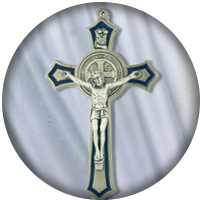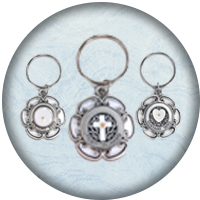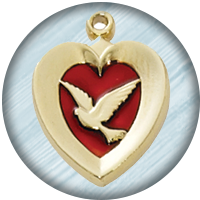ST PATRICK: Part II: Mighty Victories; Preparation for Spiritual Battle
Kathy Boh on 15th Mar 2017
ST. PATRICK
PART II: Mighty Victories;
Preparation for Spiritual Battle
PRAYERFUL PREPARATION FOR BATTLE
There is no doubt that Patrick’s rich prayer life—steeped in the scriptures and their documented victories against the enemies of God’s love and His grace—fed the courage and boldness that Patrick needed often on his journey.
One of the prayers that has been popularized in modern times is “St. Patrick’s Breast-Plate”. Such thoughts and expressions communicated in this prayer helped St. Patrick to align himself with the power and victory of God—particularly when extreme battles against demonic powers and their worshippers (the Druids) were often on his agenda. Partial quotes from this mighty prayer may give a glimpse into the intensity with which he “suited up” for spiritual warfare.
ST. PATRICK’S BREAST-PLATE
(This is both a traditional, long repeated prayer and a literal translation from the old Irish text. Only the more familiar portions are published here.)
...I bind to myself today
The virtue of the Incarnation of Christ with His Baptism,
The virtue of His crucifixion with His burial,
The virtue of His Resurrection with His Ascension,
The virtue of His coming on the Judgment Day...
I bind to myself today
God's Power to guide me
God's might to uphold me,
God's Wisdom to teach me,
God's Eye to watch over me,
God's Ear to hear me,
God's Word to give me speech,
God's Hand to guide me,
God's Way to lie before me,
God's Shield to shelter me,
God's Host to secure me.
Against the snares of demons,
Against the seductions of vices,
Against the lusts of nature,
Against everyone who meditates injury to me,
Whether far or near,
Whether few or many...
Christ, protect me today
Against every poison,
Against burning,
Against drowning, against death-wound,
that I may receive abundant reward.
Christ with me, Christ before me, Christ behind me,
Christ within me, Christ beneath me, Christ above me,
Christ at my right, Christ at my left
Christ in every eye that sees me,
Christ in every ear that hears me,
I bind to myself today
The strong virtue of the Invocation of the Trinity:
I believe the Trinity in the Unity,
The Creator of the Universe.
TARA
The name “Tara” became known through the movie, “Gone With the Wind”. But its namesake, Tara, in Ireland, was the “seat of power” for centuries during the reign of kings in Celtic Ireland. It also has a most notable connection to St. Patrick.
It was here that a very decisive victory of God was won in a very public way. The Lord had won the heart of the converted chieftain, Dichu, (as was mentioned in Part I of this series) who told Patrick that a special feast was to be celebrated at Tara. The Supreme Monarch of Ireland would be present, and all the chieftains, Druid priests, and the Brehon (law) leaders of Ireland were invited. Immediately, Patrick saw this as a grand occasion to present the “good news”.
In March of the year 433, an imperial decree went out from the High King Loaghaire to all the Irish people that all fires were to be extinguished until a blaze was lit at the monarch’s royal mansion on the next day, at Tara. *
Contrary to this edict, Patrick arrived at the opposite end of the valley from the hill of Tara, and he kindled a fire on the hill of Slane. It was a paschal fire, in honor of Easter Sunday—which occurred on the next day, the very day of the assembly. Druid leaders complained to the king, and they spoke what was to become a prophetic word. “This fire, which has been lighted in defiance of the royal edict, will blaze forever in this land unless it be this very night extinguished.”*
The king and the druids made attempts to put out the paschal fire. The leaders were even given the power to kill anyone opposing the king’s edict or resisting them, but to no avail. The assembly of those at Slane were protected by the Lord’s mighty hand. Patrick arranged a procession to form from the hill of Slane to the king’s fire atop Tara’s mount. He had a young boy leading the procession who was holding high the Gospels.
As Patrick’s assemblage made their way toward the royal assembly, the druids and their magicians worked hard voicing their best incantations, which produced a dark cloud over the entire area. It was described as “worse than Egyptian darkness”.* Their reverse efforts—at Patrick’s prompting—were in vain. They could not remove the dark cloud. Then Patrick prayed. Suddenly, the sun shone through with the brightest light and absolutely lit up the whole hill and plain. [It helps to know the “Light of the world” that overcomes the darkness…]
Again, the druids attempted their best. The Arch-Druid, Lochru, used demonic power to rise high into the air, but then Patrick publicly knelt and prayed. The Druid suddenly fell, crashed into a rock, and died. In clear view of the leaders assembled—including the king, the Irish chieftains, the druids, and the promoters of the law (the Brehons)—the druids’ evil powers were shown to be no match for the power of the true and Almighty God of St. Patrick. * [The story reminds us of Elijah’s confrontation on Mount Carmel with the 450 priests of Baal, the chief god of the Canaanites… IKings 18:16-46]
Patrick immediately spoke to the king and Ireland’s leaders who were gathered, and presented the gospel message. He used a shamrock from the ground as an analogy of the Trinity. King Loaghaire became convinced by the miracles to give his permission for Patrick to continue preaching the good news throughout the country.*
New doors opened for Patrick and his co-workers. Still, dangers existed for Patrick on his missionary journeys. During one of the journeys, while they were at a stop, his chariot driver overheard that plans were being made to kill Patrick while he traveled. He then suggested to Patrick that he be allowed to rest, exchange cloaks, and let Patrick drive. The charioteer, appearing to be Patrick, was speared as the plot was executed against them. Patrick was safe. And the charioteer became a martyr and protector of the faith.*
Even after the country of Ireland was largely converted, St. Patrick continued to travel, visit and look after the bishops and the many churches he established. Hundreds of bishops were consecrated in Patrick’s lifetime.
LEGENDS
It is easy for any person, past or present—who does not believe in the existence of demons— to think in terms of “legend” when hearing stories of God’s manifest power through St. Patrick.
There are some legends connected with St. Patrick, but accurate sources have largely been established, particularly since he was associated with some early saints, historical figures, and with the pope himself. There were witnesses and writings regarding his life and deeds—including his own “Confessio” (Confessions). That, and the “Epistola ad Coroticum” have been credited to him as genuinely written by him. “The best edition, with text, translation, and critical notes, is by Rev. Dr. White for the Royal Irish Academy, in 1905.”**
May we continue to bring God joy as we pray and cooperate with Him… as He continues to raise up and call forth men and women who are willing to follow Him into every battle against the forces of evil that surround us. Although we may find the evils we battle are less blatantly demonic in their "evil" ways, their more subtle ways are powerful and wicked nonetheless. God's power is available, and those suffering under noxious influences and powers need His freedom. Our own hearts, minds and wills—no matter what their current state— can become filled with God’s most marvelous mercy and love, and the power of His Holy Spirit. May it be so!
*Many different background sources were used. Historical information used was confirmed by at least two respected references. As mentioned in Part II, St. Patrick’s life was connected to several other saints and to the papal office. Verification, therefore, could come in many forms and from a variety of saintly and confirming sources.
**Quotations are taken from the Catholic Encyclopedia, “New Advent”, http://www.newadvent.org/cathen/11554a.htm.
(A similar blog version was posted by Kathy Boh on March 15, 2016)










